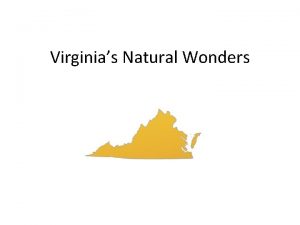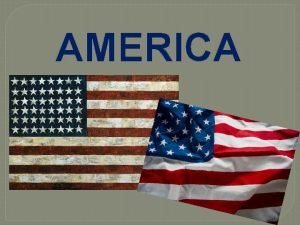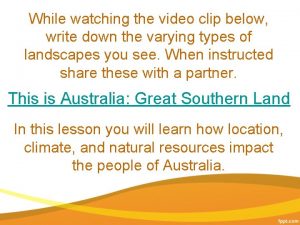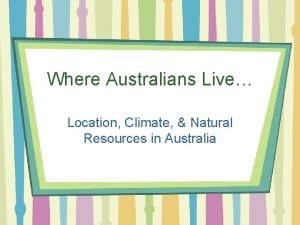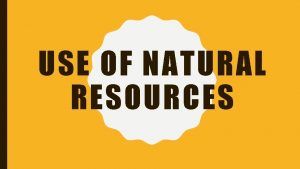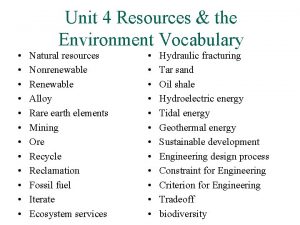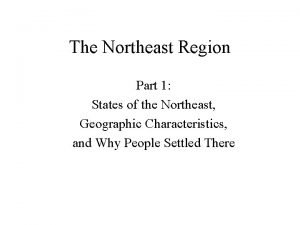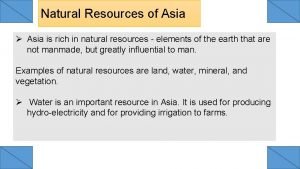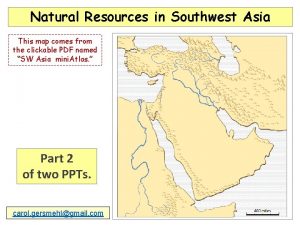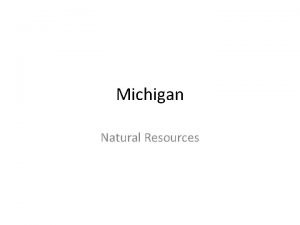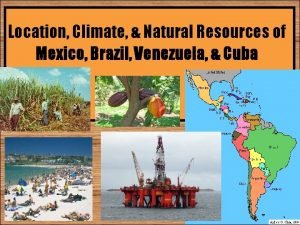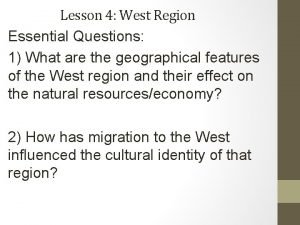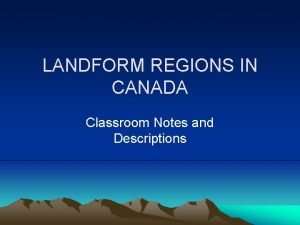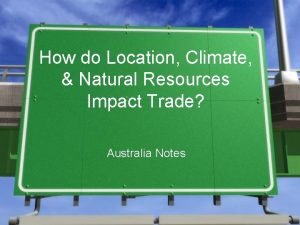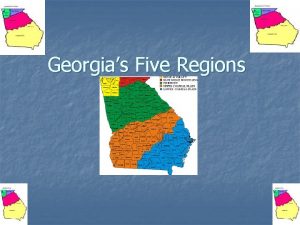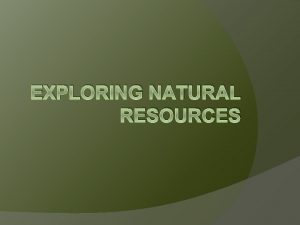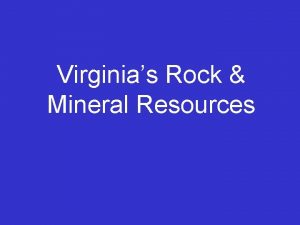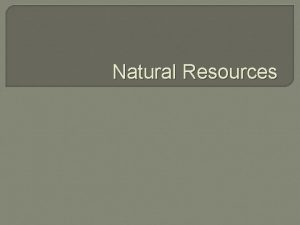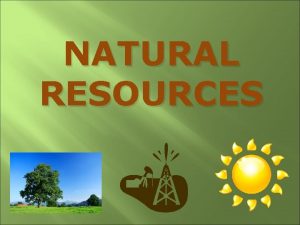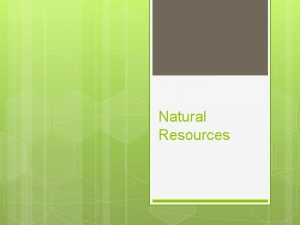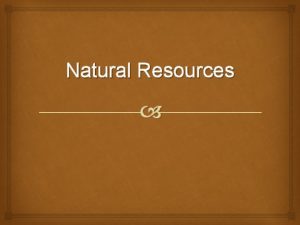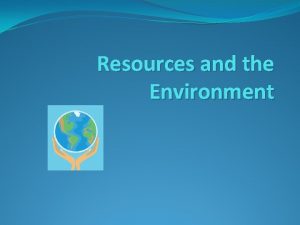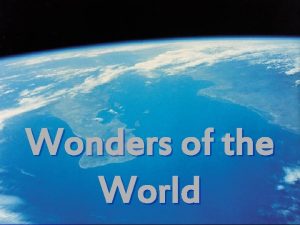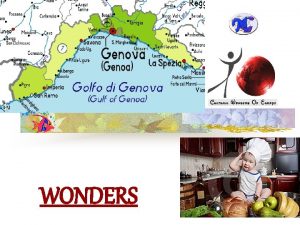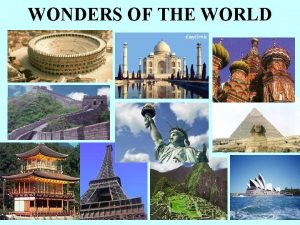Virginias Natural Wonders Virginias Natural Resources Virginia has























- Slides: 23

Virginia’s Natural Wonders

Virginia’s Natural Resources • Virginia has a rich variety of natural resources. • Natural resource things that exist in or are formed by nature. • Examples: Forests, farmland, minerals, wildlife, waterways, and wonders.

Virginia’s Forests • Lumber from Virginia’s forests is used for building materials and pulp to make paper.

Virginia’s Farmland • Virginia has good soil to grow crops and raise animals.

Virginia’s Minerals • Virginia has coal, sand, and rock for energy and building materials.

Virginia’s Wildlife • Virginia is home to many different kinds of wildlife. • There are thousands of different kinds of animals that live in Virginia.

Virginia’s Waterways • Virginia has many streams, rivers, lakes, and bays. • Virginia is also bordered to its east by a large ocean known as the Atlantic Ocean.

Virginia’s Wonders • Virginia is home to amazing natural formations of stunning beauty!

Virginia’s Five Geographic Regions • Virginia has five geographic regions that have a variety of natural resources. • The Coastal Plain (Tidewater) Region is home to many different kinds of seafood.

Virginia’s Five Geographic Regions • The Piedmont Region is home to tobacco products. • The Blue Ridge Mountains Region is famous for producing fruit.

Virginia’s Five Geographic Regions • The Valley and Ridge Region has dairy cattle, beef cattle, apples, and poultry. • The Appalachian Plateau Region is famous for coal, sand, and rocks.

Virginia’s Water Resources • Rivers – Long, ribbonlike waterways that usually flow toward an ocean, lake, bay, or other river. Rivers are fed by precipitation, snowmelt, or natural springs (water from beneath the Earth’s surface. )

Virginia’s Water Resources • Bays – Large bodies of water that are surrounded by land on three sides. Bays usually have a small channel that connects them to a larger body of water, such as an ocean.

Virginia’s Water Resources • Lakes – Large inland bodies of water. Almost all lakes hold fresh water and are fed and drained by small rivers or streams.

Virginia’s Water Resources • Oceans – Vary large bodies of salt water. Virginia is bordered to the east by the Atlantic Ocean. • Oceans cover more than 70% of the Earth’s surface and contain 97% of the planet’s water.

The Chesapeake Watershed • Watershed – an area of land where all the water above and below ground flows to the same place. • Chesapeake Watershed covers parts of six states and Washington, D. C.

The Chesapeake Watershed • Estuary – a place where salt water from the ocean mixes with freshwater from rivers and streams. • The Chesapeake watershed is the largest estuary in the United States.

The Chesapeake Watershed • Tributaries – streams that feed larger streams, lakes, or rivers.

Our Watershed Address • Virginia’s four major rivers, the Potomac, Rappahannock, York, and James, all flow into the Chesapeake Bay and finally the Atlantic Ocean. • Loudoun County is bordered by the Potomac River to the north.

Our Watershed Address • Virginia has 14 different watersheds. • Loudoun County is in the Potomac River Watershed that eventually becomes part of the Chesapeake watershed!

Watersheds – A Big Deal! • Water traveling over land can carry many things. • These things have the potential to do great harm to watersheds. • These things include: soil sediments, livestock and pet waste, fertilizers, pesticides, and other pollutants including trash and litter.

Watersheds – A Big Deal! • What happens in the tributaries of a watershed has an effect on everyone downstream! • Wildlife and animal species are connected to watersheds.

Watersheds – A Big Deal • It is important that we take care of our streams, rivers, lakes, and bays. • Humans can make a big difference in the health of watersheds by making sure not to litter, cleaning up after our pets, not using too much fertilizer or pesticides, and being sure to contain loose soil.
 Natural wonders of virginia
Natural wonders of virginia Wonders of the world 7
Wonders of the world 7 7 natural wonders of the world niagara falls
7 natural wonders of the world niagara falls Seo northern virginia
Seo northern virginia Virginia department of historic resources database
Virginia department of historic resources database Transformed and transforming resources
Transformed and transforming resources Differentiate fixed resources and variable resources
Differentiate fixed resources and variable resources Renewable vs nonrenewable resources worksheet
Renewable vs nonrenewable resources worksheet Australia major natural resources
Australia major natural resources Central australia natural resources
Central australia natural resources What are the 4 types of natural resources
What are the 4 types of natural resources Natural resources vocabulary
Natural resources vocabulary Northeast region characteristics
Northeast region characteristics Russia resources
Russia resources Malaysia rich in natural resources
Malaysia rich in natural resources Resources in southwest asia
Resources in southwest asia Natural resources found in michigan
Natural resources found in michigan Brazil main resources
Brazil main resources West region products
West region products Weather in the cordillera region canada
Weather in the cordillera region canada How does australia's location impact trade
How does australia's location impact trade The five regions of georgia
The five regions of georgia Explain natural resources
Explain natural resources Japan major natural resources
Japan major natural resources
